But this time it can fall and cause no damage because the manned spaceship will be placed on top of the missile and not next to it like the shuttle
Avi Blizovsky

The crew compartment of the spacecraft that will replace the shuttle (CEV) is launched on an Ares rocket. Illustration: "NASA"
The engineers designing the launchers that will return humans to the moon said last Tuesday that they plan to cover part of it with the kind of foam that caused the Columbia disaster and caused many problems during the space shuttle program.
The thick and crunchy foam will probably also fall out of the new rocket as happened in the shuttle's fuel tank, but NASA does not expect it to cause safety problems. The foam will be used to insulate the oxygen and hydrogen cooled to an extremely low temperature in the fuel tank. Foam has been falling from the huge orange tank since the first flights.
A piece of the foam the size of a suitcase hit one of the wings of the shuttle Columbia during launch and caused a hole that caused the spacecraft to burn up upon entering the atmosphere in February 2003. Foam also fell on the first flight after the disaster - of the shuttle Discovery.
Part of the manned rocket, known as Ares 1, will include a section similar to the outer tank of the shuttle, so it will also be required to foam. Says the missile's upper stage project manager, Danny Davis.
However, unlike in the shuttle, the astronauts sat in a cabin containing six seats on top of the rocket. This means that falling foam will not damage the cabin, said Don Krupp, director of the rocket design group at Marshall Space Center. "This is a different application," Krupp said. "If pieces of foam fall, they will fall away from the astronauts."
Davis said that the engineers working on these areas assume that the spaceship will sing foam. But this will not change anymore." said.
Davis and Krupp were among the NASA executives who met with reporters during an open house for the media at the Marshall Space Center, which is responsible for the shuttle's rockets and plans propulsion systems for the new lunar probe.
The engineers who developed the Apollo spacecraft in the 1s used calculators and hand-built models, but Ares will be designed with the help of computers. The engineers will be able to try out their ideas on virtual models, and this will allow them to more easily know which designs will not work. Ares XNUMX will be placed on top of a solid fuel booster larger than those currently accelerating the shuttle into orbit in the first minutes of launch.
Ares will fly faster and higher than the shuttle during the first few minutes after launch and this will cause it more stresses. But its cylindrical design, without the shuttle wings, tail or delicate heat shield tiles, will allow it to take off more smoothly.
"The missile will be less sensitive to launch delays due to bad weather at Cape Canaveral," Krupp said. "We are trying to design the tool so that it can take off in any weather," he said. "Our mission is not to allow the weather to shorten our launch windows."
The Venom rocket will include concepts used in both the Apollo program and the shuttle program, but Krupp says that each unit that goes into the new spacecraft will be tested as if it were brand new.
